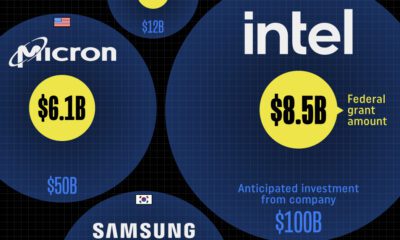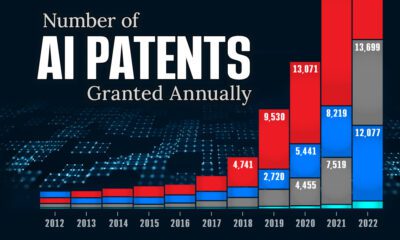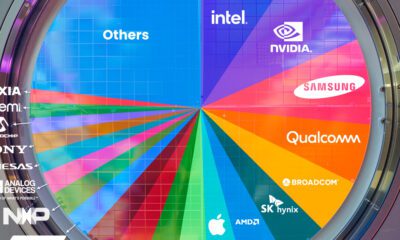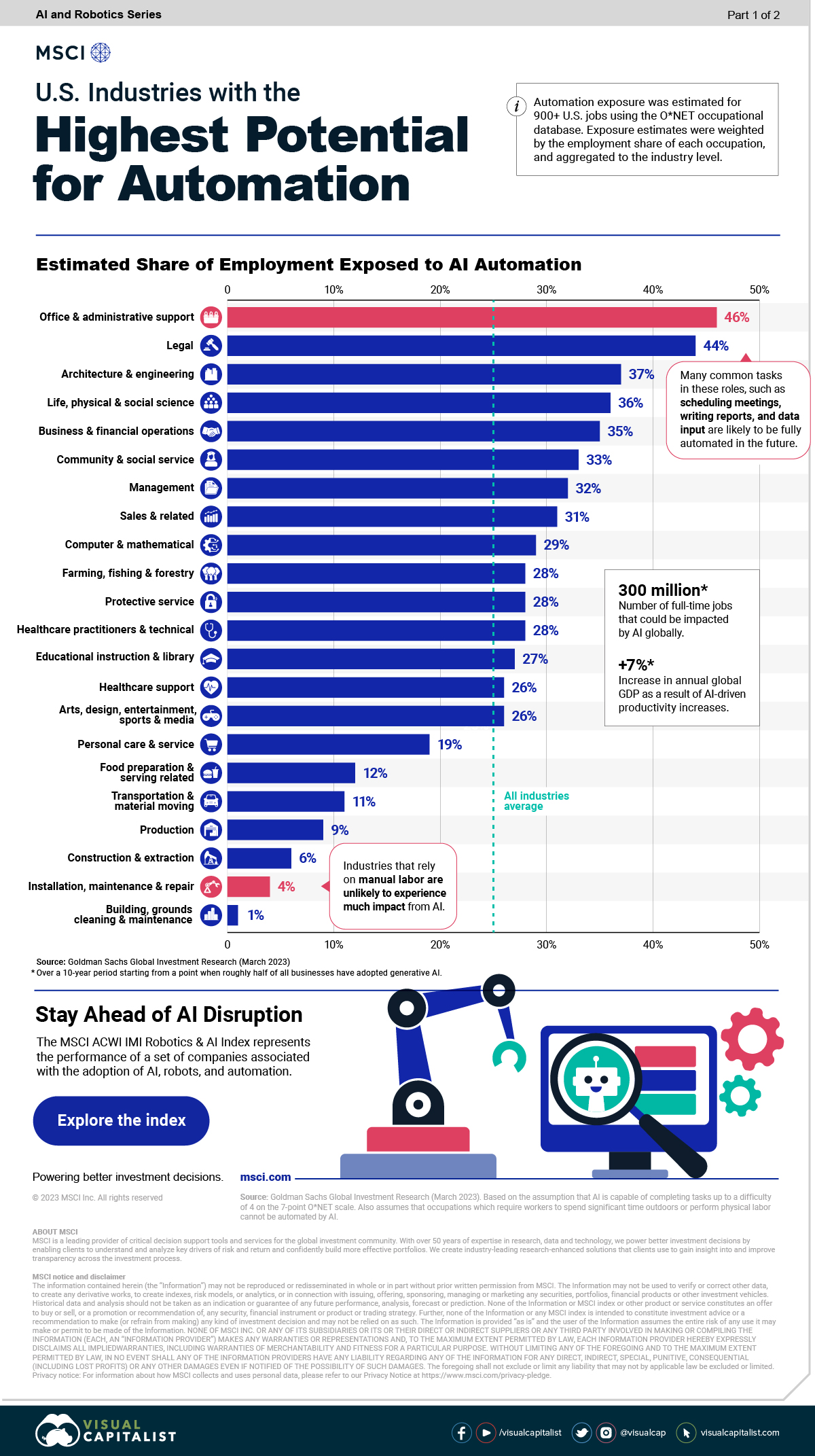Ranking Industries by Their Potential for AI Automation
Ranking Industries by Their Potential for AI Automation
Since the release of tools like ChatGPT, artificial intelligence (AI) has begun to permeate industries worldwide, transforming the way we work and live.
To gain insight into this rapidly evolving landscape, our sponsor MSCI has ranked U.S. industries by their estimated share of employment that could be exposed to AI-driven automation.
Data and Highlights
This analysis comes from a March 2023 report published by Goldman Sachs Global Investment Research.
The authors estimated automation exposure for over 900 U.S. jobs using the O*NET occupational database, which provides details on the types of tasks each occupation conducts. Exposure estimates were then weighted by the employment share of each occupation, and aggregated to the industry level.
| Industry | Estimated Share of U.S. Employment Exposed to AI (%) |
|---|---|
| Office and administrative support | 46% |
| Legal | 44% |
| Architecture and engineering | 37% |
| Life, physical, and social science | 36% |
| Business and financial operations | 35% |
| Community and social service | 33% |
| Management | 32% |
| Sales and related | 31% |
| Computer and Mathematical | 29% |
| Farming, fishing, and forestry | 28% |
| Protective service | 28% |
| Healthcare practitioners and technical | 28% |
| Educational instruction and library | 27% |
| Healthcare support | 26% |
| Arts, design, entertainment, sports, and media | 26% |
| All industries average | 25% |
| Personal care and service | 19% |
| Food preparation and serving related | 12% |
| Transportation and material moving | 11% |
| Production | 9% |
| Construction and extraction | 6% |
| Installation, maintenance, and repair | 4% |
| Building and grounds cleaning and maintenance | 1% |
According to these findings, “office and administrative support” will likely be the most affected by AI-driven automation at 46%. This transformation could largely impact common tasks such as data entry, scheduling meetings, and document management.
The second highest industry, “legal”, trails close behind at 44%. AI is expected to automate legal processes like contract analysis, and could even be used to anticipate court case outcomes.
As expected, industries that won’t be heavily impacted are those that rely heavily on manual labor, like “construction and extraction.”
Benchmarking the Automated Future
AI is still a very new and developing technology. How it will impact labor productivity in the future depends on its capability (how fast it improves) and adoption (how quickly people and businesses begin using it).
Adoption rates are unlikely to be the same around the world, as survey results have shown that some countries are more optimistic towards AI than others.
Under the most aggressive scenario, Goldman Sachs believes that AI automation could impact up to 300 million jobs globally and potentially result in a 7% increase in annual GDP (equal to about $7 trillion).
Given AI’s massive potential for disruption, it’s more important than ever for investors to stay ahead. That’s why MSCI has created the MSCI ACWI IMI Robotics & AI Index, which benchmarks an investable universe of companies associated with the adoption of AI, robotics, and automation.

Explore the MSCI ACWI IMI Robotics & AI Index now

-

 Technology11 hours ago
Technology11 hours agoAll of the Grants Given by the U.S. CHIPS Act
Intel, TSMC, and more have received billions in subsidies from the U.S. CHIPS Act in 2024.
-

 Technology2 days ago
Technology2 days agoVisualizing AI Patents by Country
See which countries have been granted the most AI patents each year, from 2012 to 2022.
-

 Brands4 days ago
Brands4 days agoHow Tech Logos Have Evolved Over Time
From complete overhauls to more subtle tweaks, these tech logos have had quite a journey. Featuring: Google, Apple, and more.
-

 Technology2 weeks ago
Technology2 weeks agoRanked: Semiconductor Companies by Industry Revenue Share
Nvidia is coming for Intel’s crown. Samsung is losing ground. AI is transforming the space. We break down revenue for semiconductor companies.
-

 AI3 weeks ago
AI3 weeks agoThe Stock Performance of U.S. Chipmakers So Far in 2024
The Nvidia rocket ship is refusing to slow down, leading the pack of strong stock performance for most major U.S. chipmakers.
-

 Technology3 weeks ago
Technology3 weeks agoRanked: The Most Popular Smartphone Brands in the U.S.
This graphic breaks down America’s most preferred smartphone brands, according to a December 2023 consumer survey.



